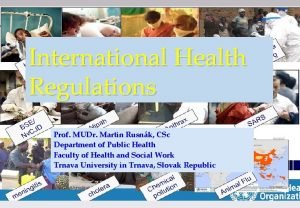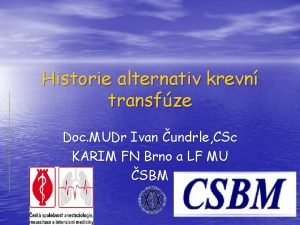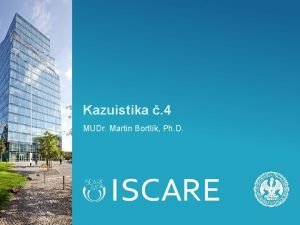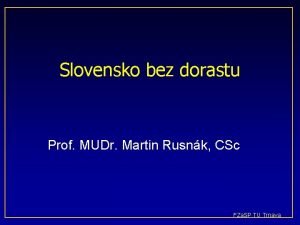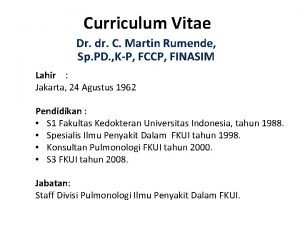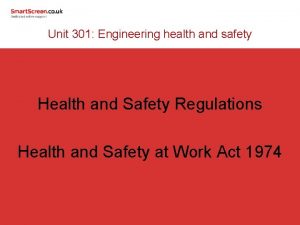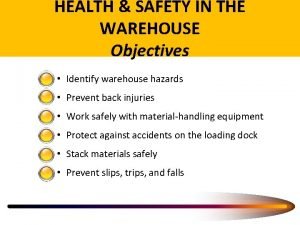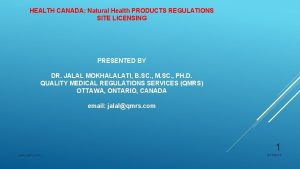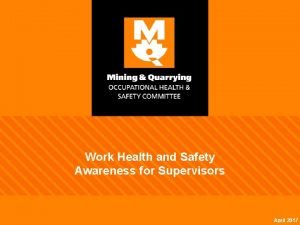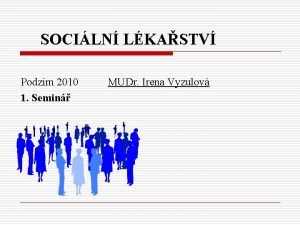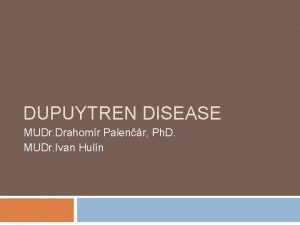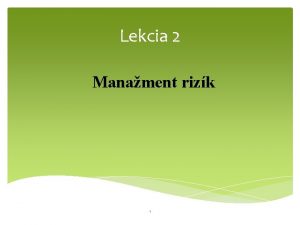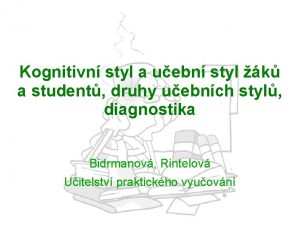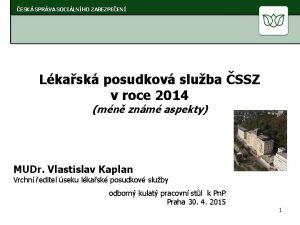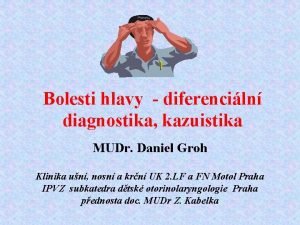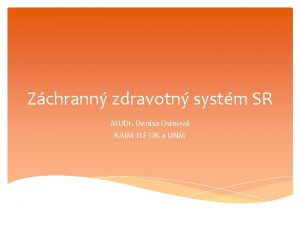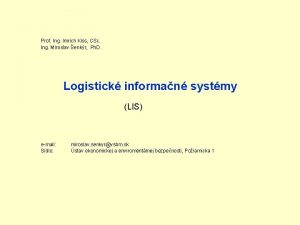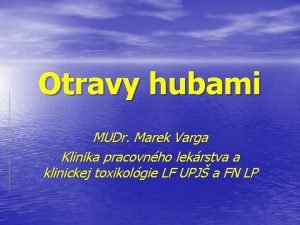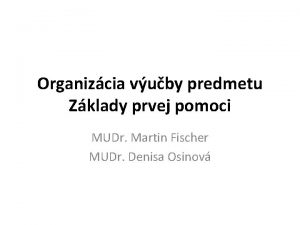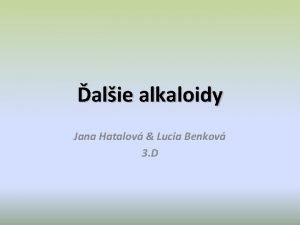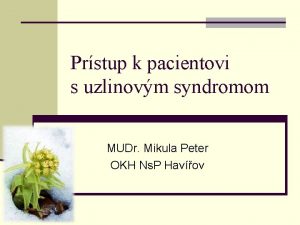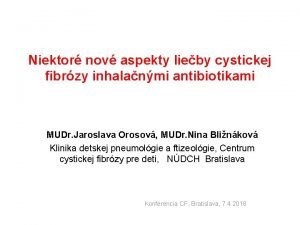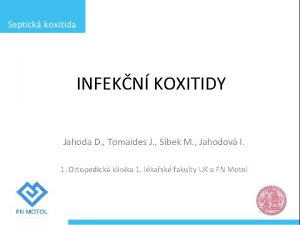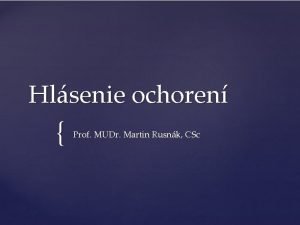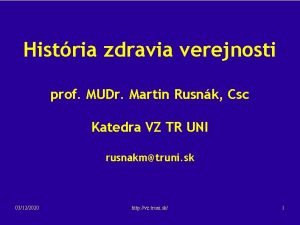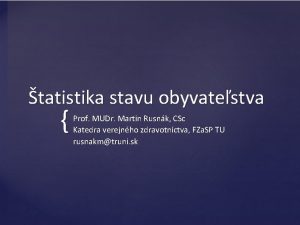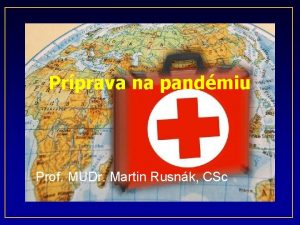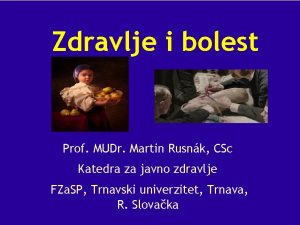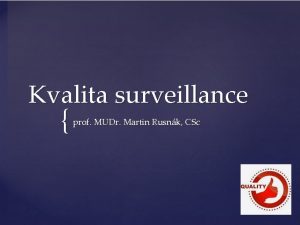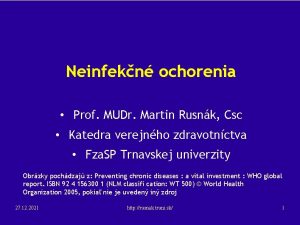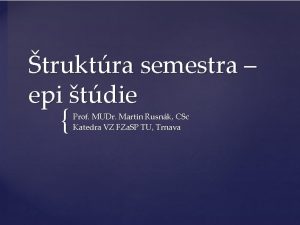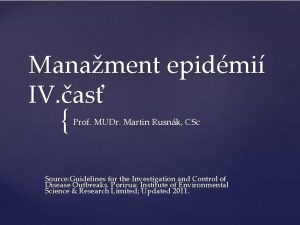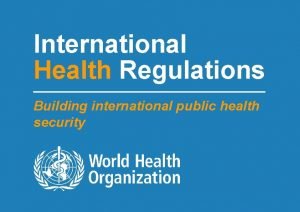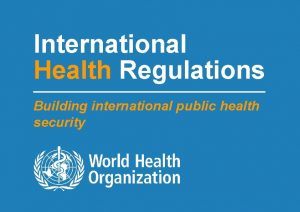International Health Regulations Prof MUDr Martin Rusnk CSc







































- Slides: 39

International Health Regulations { Prof. MUDr. Martin Rusnák, CSc Department of Public Health Faculty of Health and Social Work Trnava University in Trnava, Slovak Republic

What is IHR Why IHR is important WHO strategy National Focal Points Cases PHEIC National capacities Structure 2 rusnakm@truni. sk 8. 9. 2021

Participants will: Understand the IHR within a concept of public health surveillance Recognize the PHEIC and be able to react adequately Understand local capacities for IHR Learning objectives 3 rusnakm@truni. sk 8. 9. 2021

Formal code of conduct for public health emergencies of international concern. They're a matter of responsible citizenship and collective protection. They involve all 193 World Health Organization member countries. International Health Regulations 4 rusnakm@truni. sk 8. 9. 2021

They are an international agreement that gives rise to international obligations. They focus on serious public health threats with potential to spread beyond a country's border to other parts of the world. Such events are defined as public health emergencies of international concern, or PHEIC. The revised International Health Regulations outline the assessment, the management and the information sharing for PHEICs. IHR cntd. 5 rusnakm@truni. sk 8. 9. 2021

IHRs serve a common interest. First of all, they address serious and unusual disease events that are inevitable in our world today. They serve a common interest by recognizing that a health threat in one part of the world can threaten health anywhere, or everywhere. And they are a formal code of conduct that helps contain or prevent serious risks to public health, while discouraging unnecessary or excessive traffic or trade restrictions for, quote, "public health, " purposes. IHR cntd. 6 rusnakm@truni. sk 8. 9. 2021

The International Health Regulations (“the IHR” or “Regulations”) were adopted by the Health Assembly in 19691, Preceded by the International Sanitary Regulations adopted by the Fourth World Health Assembly in 1951. The 1969 Regulations, which initially covered six “quarantinable diseases” were amended in 1973 and 1981, primarily to reduce the number of covered diseases from six to three (yellow fever, plague and cholera) and to mark the global eradication of smallpox. In consideration of the growth in international travel and trade, and the emergence or re-emergence of international disease threats and other public health risks, the Forty-eighth World Health Assembly in 1995 called for a substantial revision of the Regulations adopted in 19694. The IHR (2005) were adopted by the Fifty-eighth World Health Assembly on 23 May 20057. They entered into force on 15 June 2007. Short history 7 rusnakm@truni. sk 8. 9. 2021

Why we need IHR? 8 rusnakm@truni. sk 8. 9. 2021

Serious and unusual disease events are inevitable Globalisation - problem in one location is everybody’s headache An agreed International Public Health code of conduct for a global approach Global movement of people 9 rusnakm@truni. sk 8. 9. 2021

SARS 8. 9. 2021 rusnakm@truni. sk 10

Influenza 8. 9. 2021 rusnakm@truni. sk 11

HIV/AIDS 8. 9. 2021 rusnakm@truni. sk 12

Bird Flu 8. 9. 2021 rusnakm@truni. sk 13

Variola 8. 9. 2021 14 rusnakm@truni. sk

Chikungunya 8. 9. 2021 rusnakm@truni. sk 15

Swine Flu 8. 9. 2021 16 rusnakm@truni. sk

8. 9. 2021 17 rusnakm@truni. sk

Ebola 18 rusnakm@truni. sk 8. 9. 2021

Strategy WHO 2008. International health regulations (2005) -2 nd ed. Geneva: World Halth Organization. 19 rusnakm@truni. sk 8. 9. 2021

Public Health Emergency of International Concern means an extraordinary event which is determined, as provided in these Regulations: to constitute a public health risk to other States through the international spread of disease, and to potentially require a coordinated international response. PHEIC 20 rusnakm@truni. sk 8. 9. 2021

The parameters for notification to WHO of all events which may constitute a public health emergency of international concern (PHEIC) are based on the following criteria: seriousness of the public health impact of the event; unusual or unexpected nature of the event; potential for the event to spread internationally; and/or the risk that restrictions to travel or trade may result because of the event. Timely and transparent notification of events combined with a collaborative assessment of the risks by the concerned State and WHO, along with effective risk communication will reduce the potential for international disease spread and the likelihood of unilateral imposition of trade or travel restrictions by other countries. Parameters for notification to WHO 21 rusnakm@truni. sk 8. 9. 2021

All cases of these : smallpox, poliomyelitis due to wild-type poliovirus, SARS and cases of human influenza caused by a new subtype. Case definitions for each of these four diseases have been prepared by WHO and posted at on its website at www. who. int/ihr. Four diseases that must be automatically notified to WHO 22 rusnakm@truni. sk 8. 9. 2021

• 3 domains • 7 areas of work • Build on existing • WHO alert & response operations • WHO (relevant) control programmes (e. g. GIP, ADE, ERI, IVB, POL, FOS, PHE …) • Regional strategies for surveillance & response (e. g. joint WPRO/SEARO, PAHO, IDSR in AFRO & EMRO) • 23 … Elements for a WHO strategy rusnakm@truni. sk 8. 9. 2021

Alert & Response Ops Coordination Monitoring • Reporting • Resource mobilisation • Administration • IHR Bodies & Procedures IHR Focal Points • Roster of experts • Emergency Committee • Review Committee • National legislation Project Management WHO Alert, Preparedness, and Response Operations • education • advocacy • Intelligence • Verification • Risk assessment Risk communication • Notification • Response Specific threats IHR Communication information IHR Contact Point • • • influenza • polio • smallpox • SARS • • National Core Capacity Chemical/Radionuclear others Country Alert & Response IHR NFP Operations • National ARO • Laboratory training / support • Points of Entry • Ports • Airports • Ground crossings • Epidemiology training / support • National system assessment Response preparedness • -Social mobilization -Case management

Coordination: Many players to bring on board Potential Donors WHO Senior Management Country IHR Focal Points International Organisations (FAO, OIE, WTO, …) 25 rusnakm@truni. sk Country relevant professionals WHO Country Offices Media / The public Regional Organizations (ASEAN, EU, …) WHO Governing Bodies 8. 9. 2021

Event notification and determination under IHR (2005) Determine whether an event constitutes a PHEIC and recommend measures Receive, assess and respond to events notified Consult events or notify WHO of any events that may constitute a PHEIC Detect and report any urgent or unexpected events 26 rusnakm@truni. sk External advice Emergency Committee WHO DG Coordinate Other competent Organizations (IAEA etc. ) WHO IHR Contact Points Communicate National IHR Focal Points Various disease and event surveillance systems within a country Ministries/ Sectors Concerned Report 8. 9. 2021

IHR M & E : 5 Pillars System Pillar 1 Pillar 2 Policy Planning Financing IHR Infrastructures & Institutions Legal framework for IHR National Plan for PHEIC National IHR Focal Point for communicat ion with Media Points of Entry Budget National allocation for Emergency IHR Committee Pillar 3 IHR Human Resources knowledge & skills IHR training & continuous education Roster of professional with IHR “qualification ” Active Participation in Int. IHR related Networks Pillar 4 Pillar 5 IHR Technical Resources IHR Systems and Services IHR Resources Mapping Telecommun ication Resources Infection Control SOPs Clinical Management guidelines for PHEIC Early Warning System Verification and risk assessment system Rapid Investigation & Response Team Equipment and Stockpiles Functioning laboratory system for PHEIC WHO Resources IDSR–APSED–EID–HMN 27 rusnakm@truni. sk GOARN – EMS – E-Health- Global Atlas – Health Mapper – CSUN- GLADNet… 8. 9. 2021

Strengthened national capacity for surveillance and control, including in travel and transport Prevention, alert and response to public health emergencies of international concern Rights, obligations and procedures, and progress monitoring Global partnership and international collaboration What do the IHR call for? 28 rusnakm@truni. sk 8. 9. 2021

Step 1: Review of the National Action Plan (or equivalent) for strengthening IHR core capacities and the results of the IHR Monitoring Tool, together with information from other sources. Step 2: Consultation with relevant sectors wherever necessary and approval by appropriate authorities. Step 3: Development of IHR implementation plan or equivalent (for extension period) and dissemination to relevant stakeholders Step 4: Report and request for extension as needed Step 5: Follow up actions Local/National Activities 29 rusnakm@truni. sk 8. 9. 2021

Kaliner E, Moran-Gilad J, Grotto I, Somekh E, Kopel E, Gdalevich M, Shimron E, Amikam Y, Leventhal A, Lev B, Gamzu R. Silent reintroduction of wild-type poliovirus to Israel, 2013 – risk communication challenges in an argumentative atmosphere. Euro Surveill. 2014; 19(7): pii=20703. Israel has been certified as polio-free by the World Health Organization and its routine immunization schedule consists of inactivated poliovirus vaccine (IPV) only. At the end of May 2013, the Israeli Ministry of Health (MOH) has confirmed the reintroduction of wild-type poliovirus 1 into the country. Documented ongoing humanto-human transmission necessitated a thorough risk assessment followed by a supplemental immunization campaign using oral polio vaccine (OPV). The unusual situation in which ongoing poliovirus transmission was picked up through an early warning system of sewage monitoring without active polio cases, brought about significant challenges in risk communication. Case study of wild polio 30 rusnakm@truni. sk 8. 9. 2021

International spread of wild-type poliovirus in 2014 declared a Public Health Emergency of International Concern under the International Health Regulations (IHR). 28 May 2014 On 5 May 2014, the Director-General of the World Health Organization (WHO), Dr Margaret Chan, acted on the recommendation of the International Health Regulations Emergency Committee and declared that the spread of wild-type poliovirus (WPV) in 2014 constitutes a Public Health Emergency of International Concern (PHEIC) in accordance with the International Health Regulations (IHR) [1]. This is the second time that a PHEIC has been declared under IHR 2005. The first time was for pandemic influenza A(H 1 N 1) in 2009. In a press conference held by WHO on 5 May 2014, Dr Bruce Aylward, WHO Assistant Director. General responsible for polio eradication, stated that if ‘the situation as of today and April 2014 is unchecked, it could result in the failure to eradicate globally one of the world’s most serious vaccine-preventable diseases’. As a result of the PHEIC, WHO issued temporary recommendations for controlling the spread of polioviruses. This Rapid Risk Assessment examines the implications of the temporary recommendations for EU Member States and assesses whether the developments leading to the declaration of a PHEIC represent an increased risk of WPV importation to, and sustained transmission in, Member States of the European Union. It also considers practical suggestions for implementing the WHO recommendations in the EU. Reaction 31 rusnakm@truni. sk 8. 9. 2021

Following the declaration of a PHEIC, WHO has issued temporary recommendations that will be re-assessed in three months [1]. The main purpose of the measures presented in the temporary recommendations is to reduce the risk of international spread of wild-type poliovirus before the high WPV transmission season in May and June. The WHO recommendations divide the 10 polio-affected countries into two groups. Three ‘currently exporting countries’ (Pakistan, Cameroon and Syria) from which the virus has been carried to other countries in 2014. Seven countries (Afghanistan, Equatorial Guinea, Ethiopia, Iraq, Israel, Somalia and Nigeria) which are affected but are currently not exporting poliovirus. PHEIC Public Health Emergency of International Concern 32 rusnakm@truni. sk 8. 9. 2021

The three exporting countries are requested to ensure that all residents and long-term visitors (defined as those staying in the country for more than four weeks) receive a dose of either OPV or IPV between four weeks and 12 months prior to international travel. Countries have to ensure that such travellers are provided with an International Certificate of Vaccination or Prophylaxis in the form specified in Annex 6 of the International Health Regulations (2005) to record their polio vaccination and serve as proof of vaccination. The seven non-exporting countries are requested to encourage the same vaccinations and ensure that travellers who receive such vaccination have access to an appropriate document to record their polio vaccination status. In addition, the 10 countries have to officially declare – if they have not already done so – at the level of head of state or government, that the interruption of poliovirus transmission is a national public health emergency. They have to maintain these measures until the following criteria have been met: (i) at least six months have passed without the detection of wild poliovirus transmission in the country from any source, and (ii) there is documentation of full application of high-quality eradication activities in all infected and high risk areas. Control measures 33 rusnakm@truni. sk 8. 9. 2021

Continuous and heavy rainfall from 14 to 16 May 2014 resulted in extensive flooding in Bosnia and Herzegovina, Croatia, and Serbia, mainly around the Sava river catchment area. It was considered the worst flood since the beginning of record keeping in the region. On 25 May, the World Health Organization’s Regional Office for Europe (WHO/EURO) reported that two million people were affected by the flooding, more than 60 000 were displaced, and 60 people died in the three countries [4]. In the affected areas, 61 healthcare facilities were damaged. Prevention and control measures against infectious diseases were focused on water- and vector-borne diseases, together with psychological support. The flood water slowly receded and has currently returned to normal water levels in most places. As of 13 June 2014, the number of displaced persons decreased from nearly 60 000 to 22 500 persons in the three countries. Current efforts are focused on the reestablishment of general services (water, centralised wastewater collection/treatment services, transportation and electricity), general cleaning (debris removal, disposal of waste), disinfection and rodent control. Floods in Bosnia and Herzegovina, Croatia, and Serbia: communicable disease risks 18 June 2014 34 rusnakm@truni. sk 8. 9. 2021

35 rusnakm@truni. sk 8. 9. 2021

According to WHO/EURO, as of 13 June 2014, no outbreaks of communicable diseases have been reported in the affected areas. WHO/EURO also reported that the early response phase had ended, which focused on enhanced epidemiological surveillance, the strengthening of early warning systems for communicable diseases, and the prevention of water- and vector-borne infections. A post-disaster needs assessment is underway for Bosnia and Herzegovina and Serbia. Vector control measures are ongoing in the three countries (aerial spraying of some floodaffected municipalities). WHO conclusions 36 rusnakm@truni. sk 8. 9. 2021

IHR = Formal code of conduct for public health emergencies of international concern. Globalisation - problem in one location is everybody’s headache Public Health Emergency of International Concern PHEIC means an extraordinary event National approach: IHR implementation plan and dissemination to relevant stakeholders Case studies: wild polio, floods in Balkan Summary 37 rusnakm@truni. sk 8. 9. 2021

NATIONAL, RESEARCH & COUNCIL 2014. An All-of. Government Approach to Increase Resilience for International Chemical, Biological, Radiological, Nuclear, and Explosive (CBRNE) Events: A Workshop Summary. Steering Committee on An All-of-Government Approach to Increase Resilience for International Chemical, Biological, Radiological, Nuclear, and Explosive (CBRNE) Events, Division on Earth and Life Studies. Washington, DC: The National Academies Press. HUFNAGEL, L. , BROCKMANN, D. & GEISEL, T. 2004. Forecast and control of epidemics in a globalized world. Proceedings of the National Academy of Sciences. , 101, 15124 -15129. WILSON, K. , MCDOUGALL, C. , FIDLER, D. P. & LAZAR, H. 2008. Strategies for implementing the new International Health Regulations in federal countries. Bull World Health Organ, 86, 21520. Further reading 38 rusnakm@truni. sk 8. 9. 2021

See you in Trnava 39 rusnakm@truni. sk 8. 9. 2021
 Rusnk
Rusnk Doc. mudr. ivan čundrle csc
Doc. mudr. ivan čundrle csc Mudr martin nouza
Mudr martin nouza David belada
David belada Mudr martin rusnak
Mudr martin rusnak Priemerny vek prvorodiciek
Priemerny vek prvorodiciek Martin rumende
Martin rumende Wiwi upb prüfungstermine
Wiwi upb prüfungstermine Health and safety at work act engineering
Health and safety at work act engineering Six pack health and safety regulations
Six pack health and safety regulations Warehousing health and safety
Warehousing health and safety Six pack regulations
Six pack regulations Natural health product licensing
Natural health product licensing Work health and safety regulations 2012 sa
Work health and safety regulations 2012 sa Mudr. aleš sendler úmrtí
Mudr. aleš sendler úmrtí Mudr. filip hudeček
Mudr. filip hudeček Mudr. katarína hrubišková
Mudr. katarína hrubišková Palenr
Palenr Proelastaza
Proelastaza Hypestesie
Hypestesie Mudr. radek girgle
Mudr. radek girgle Mudr trebuna
Mudr trebuna Mudr bidrmanová
Mudr bidrmanová Gynkomed
Gynkomed Mudr. vlastislav kaplan
Mudr. vlastislav kaplan Orbitocellulitis
Orbitocellulitis Mudr. jana gandalovičová
Mudr. jana gandalovičová Mudr denisa osinova
Mudr denisa osinova Mudr. imrich kiss
Mudr. imrich kiss Hemoperfuzia
Hemoperfuzia Denisa osinova
Denisa osinova Mudr. monika czirfuszová
Mudr. monika czirfuszová Alkaloid čaju
Alkaloid čaju Mudr mikula
Mudr mikula Mudr. jaroslava orosová ml.
Mudr. jaroslava orosová ml. Mudr. radek girgle
Mudr. radek girgle Mudr. jozef firment
Mudr. jozef firment Mudr tomaides
Mudr tomaides Mudr rozenbergová
Mudr rozenbergová Frenuloplastika cena
Frenuloplastika cena
